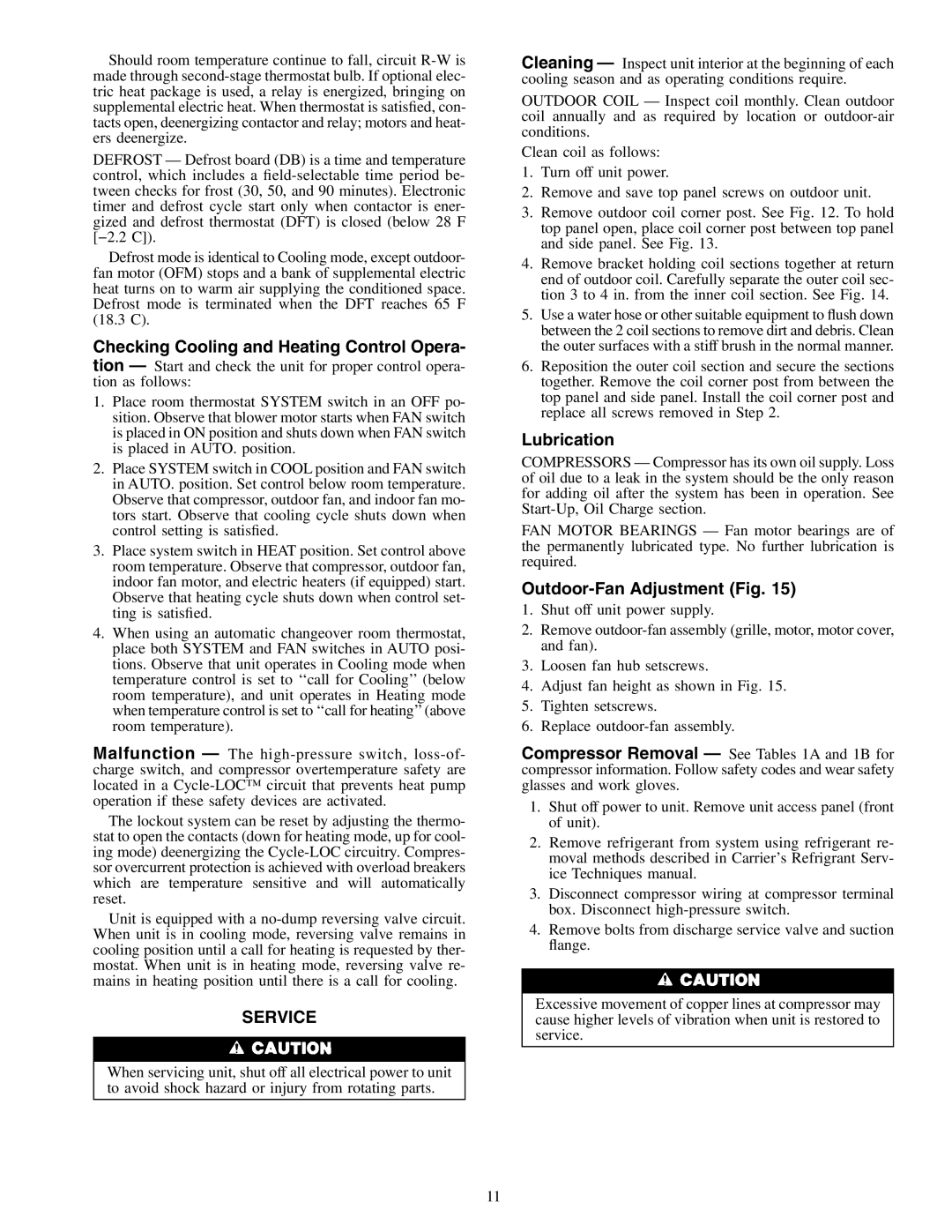Should room temperature continue to fall, circuit R-W is made through second-stage thermostat bulb. If optional elec- tric heat package is used, a relay is energized, bringing on supplemental electric heat. When thermostat is satisfied, con- tacts open, deenergizing contactor and relay; motors and heat- ers deenergize.
DEFROST — Defrost board (DB) is a time and temperature control, which includes a field-selectable time period be- tween checks for frost (30, 50, and 90 minutes). Electronic timer and defrost cycle start only when contactor is ener- gized and defrost thermostat (DFT) is closed (below 28 F [−2.2 C]).
Defrost mode is identical to Cooling mode, except outdoor- fan motor (OFM) stops and a bank of supplemental electric heat turns on to warm air supplying the conditioned space. Defrost mode is terminated when the DFT reaches 65 F (18.3 C).
Checking Cooling and Heating Control Opera-
tion — Start and check the unit for proper control opera- tion as follows:
1.Place room thermostat SYSTEM switch in an OFF po- sition. Observe that blower motor starts when FAN switch is placed in ON position and shuts down when FAN switch is placed in AUTO. position.
2.Place SYSTEM switch in COOL position and FAN switch in AUTO. position. Set control below room temperature. Observe that compressor, outdoor fan, and indoor fan mo- tors start. Observe that cooling cycle shuts down when control setting is satisfied.
3.Place system switch in HEAT position. Set control above room temperature. Observe that compressor, outdoor fan, indoor fan motor, and electric heaters (if equipped) start. Observe that heating cycle shuts down when control set- ting is satisfied.
4.When using an automatic changeover room thermostat, place both SYSTEM and FAN switches in AUTO posi- tions. Observe that unit operates in Cooling mode when temperature control is set to ‘‘call for Cooling’’ (below room temperature), and unit operates in Heating mode when temperature control is set to ‘‘call for heating’’ (above room temperature).
Malfunction — The high-pressure switch, loss-of- charge switch, and compressor overtemperature safety are located in a Cycle-LOC™ circuit that prevents heat pump operation if these safety devices are activated.
The lockout system can be reset by adjusting the thermo- stat to open the contacts (down for heating mode, up for cool- ing mode) deenergizing the Cycle-LOC circuitry. Compres- sor overcurrent protection is achieved with overload breakers which are temperature sensitive and will automatically reset.
Unit is equipped with a no-dump reversing valve circuit. When unit is in cooling mode, reversing valve remains in cooling position until a call for heating is requested by ther- mostat. When unit is in heating mode, reversing valve re- mains in heating position until there is a call for cooling.
SERVICE
When servicing unit, shut off all electrical power to unit to avoid shock hazard or injury from rotating parts.
Cleaning — Inspect unit interior at the beginning of each cooling season and as operating conditions require.
OUTDOOR COIL — Inspect coil monthly. Clean outdoor coil annually and as required by location or outdoor-air conditions.
Clean coil as follows:
1.Turn off unit power.
2.Remove and save top panel screws on outdoor unit.
3.Remove outdoor coil corner post. See Fig. 12. To hold top panel open, place coil corner post between top panel and side panel. See Fig. 13.
4.Remove bracket holding coil sections together at return end of outdoor coil. Carefully separate the outer coil sec- tion 3 to 4 in. from the inner coil section. See Fig. 14.
5.Use a water hose or other suitable equipment to flush down between the 2 coil sections to remove dirt and debris. Clean the outer surfaces with a stiff brush in the normal manner.
6.Reposition the outer coil section and secure the sections together. Remove the coil corner post from between the top panel and side panel. Install the coil corner post and replace all screws removed in Step 2.
Lubrication
COMPRESSORS — Compressor has its own oil supply. Loss of oil due to a leak in the system should be the only reason for adding oil after the system has been in operation. See Start-Up, Oil Charge section.
FAN MOTOR BEARINGS — Fan motor bearings are of the permanently lubricated type. No further lubrication is required.
Outdoor-Fan Adjustment (Fig. 15)
1.Shut off unit power supply.
2.Remove outdoor-fan assembly (grille, motor, motor cover, and fan).
3.Loosen fan hub setscrews.
4.Adjust fan height as shown in Fig. 15.
5.Tighten setscrews.
6.Replace outdoor-fan assembly.
Compressor Removal — See Tables 1A and 1B for compressor information. Follow safety codes and wear safety glasses and work gloves.
1.Shut off power to unit. Remove unit access panel (front of unit).
2.Remove refrigerant from system using refrigerant re- moval methods described in Carrier’s Refrigrant Serv- ice Techniques manual.
3.Disconnect compressor wiring at compressor terminal box. Disconnect high-pressure switch.
4.Remove bolts from discharge service valve and suction flange.
Excessive movement of copper lines at compressor may cause higher levels of vibration when unit is restored to service.

